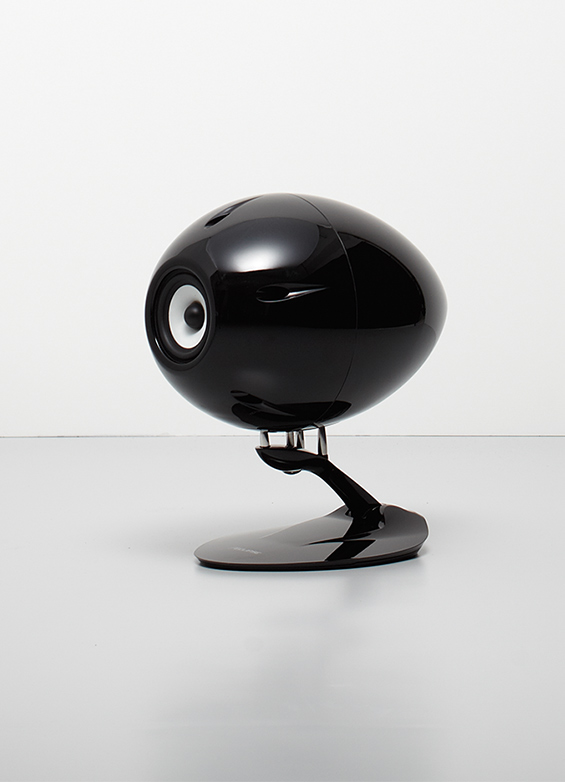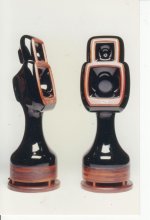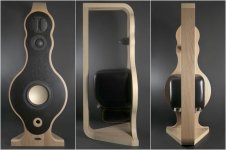There are a number of studies for the lowest diffraction enclosures (ie. Olsen, Modern Sound Reproduction) often reprinted in other books.
Lowest diffraction is the sphere, followed by tapered back compound front like the speaker (Avalon Acoustic) in post#1. Even the tall narrow box is not too bad.
Lowest diffraction is the sphere, followed by tapered back compound front like the speaker (Avalon Acoustic) in post#1. Even the tall narrow box is not too bad.
Lowest diffraction is the sphere.
Olson did not test every shape. B&W has taken his studies further and the ideal shape is more like the teradrop they use in the Nautilus or that Eclipse uses for their FRs. Also backed up by studies on the shape of cars & bike helmets as further examples.

dave
I think the wide baffle is not just about diffraction but about dispersion control. A good combination. 🙂
This sounds affordable. Can you show a pic or two as an example?
Thanks,
John
Not really, I had no need to take photos back then, though there were some on horn apps at one time, what I was normally damping, but a search turned up nothing other than this variation: http://www.12voltnews.com/wp-conten...le-solutions-speaker-examples-ab-1024x502.jpg
.....then cover the baffle with this : The Foam Factory, Open Cell Foam, Speaker Foam, Filter Foam
This would be for mixing densities, otherwise just cut a hole in the big sheet. Note that overlapping the driver some can be beneficial, so plenty of options to try with each type driver.
A minimalist adaptation of shaped foam inserts [four pieces] to damp a 800 Hz horn in a cab recess [click on pictures to open, enlarge]: http://www.lansingheritage.org/images/altec/specs/home-systems/model-19/page1.jpg
Another one I saw early on was a DIY multi-way that the mid, tweeters were in a minimalist tube assembly with a very rounded, carved foam overlay that looked awesome and combined with a foam cladded bass bin measured about as good as one could expect.
Anyway, fairly cheap, easy with lots of shape, density options assuming no strict WAF, etc., restrictions and can make or break how a speaker sounds in room, especially larger ones.
GM
I would start a SFStradivarius clone project any day, IF I was allowed to put them in our living room. Same problem with Magico S5s.
P.s. foam on baffle helps only at high treble
P.s. foam on baffle helps only at high treble
Last edited:
Ops, I meant the felt inserts on the baffle
David Ralph's Speaker Pages - Felt Effects on Baffle Diffraction
David Ralph's Speaker Pages - Felt Effects on Baffle Diffraction
And about baffle diffractions - the best way to avoid them is tu use a dipole or cardioid system below it's dipole peak range! Then we don't encounter edge diffractions until we reach say 6kHz with a minimal baffle width! This means usually a 4-way construction like Linkwitz's LX521 or Kreskowsky's NaO Note II! My attempt in this genre is in my signature AINOgradient
The principles of a dipole multiway speaker are well explained by Rudolf Finke at his homepage Dipolplus - Alles über offene Schallwände (in PDF in English
http://www.dipolplus.de/downloads/Open baffle 1.pdf )

The principles of a dipole multiway speaker are well explained by Rudolf Finke at his homepage Dipolplus - Alles über offene Schallwände (in PDF in English
http://www.dipolplus.de/downloads/Open baffle 1.pdf )

Last edited:
I would start a SFStradivarius clone project any day, IF I was allowed to put them in our living room. Same problem with Magico S5s.
P.s. foam on baffle helps only at high treble
That is the thing - a good baffle design that not only minimize diffraction but looks good too. There are some good designs on this thread but either they are not easy on the eyes or too difficult to make for DIY. As for the Stradivari, it may eliminate some of the diffraction issues, but introduces other problems. I don't think the wide baffle images very well. I actually have the Stradivari clone and especially at low frequencies, there are some phasy things that shifts the image around. Maybe it's my room but a pair of good monitors don't have this problem on the same setup.
Build you speaker into a wall so that you don't have an acoustic impedance change.
Btw: its the norm in po studio's. Not that they use the most accurate speaker systems out there, they mostly need to go loud as %#@*.
Btw: its the norm in po studio's. Not that they use the most accurate speaker systems out there, they mostly need to go loud as %#@*.
Build you speaker into a wall so that you don't have an acoustic impedance change.
Btw: its the norm in po studio's. Not that they use the most accurate speaker systems out there, they mostly need to go loud as %#@*.
Would be difficult to move around ... to a new place. I'd like my speakers to be able to wiggle and shake a bit.

The grilles are on 1/4" thick panels that raise the baffle to the edges of the top and bottom and to the side panels.
What? And I haven't even posted pix of my felt and fur covered speakers.There are some good designs on this thread but either they are not easy on the eyes...

I've heard minimum baffle designs and wide body speakers. I have to say I prefer the latter by a fair margin.
Other minimum baffle designs include designs from Linkwitz as well as Vandersteen.
Thiels (old designs) seemed to be normal width, but big rounded edges.
Here is a pic I dug up of the Snell A/III with the top removed:

Other minimum baffle designs include designs from Linkwitz as well as Vandersteen.
Thiels (old designs) seemed to be normal width, but big rounded edges.
Here is a pic I dug up of the Snell A/III with the top removed:

- Home
- Loudspeakers
- Multi-Way
- What are some good example of baffle design to improve diffraction



